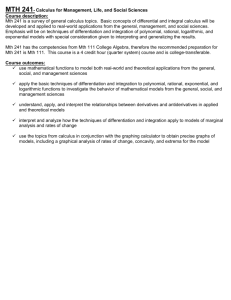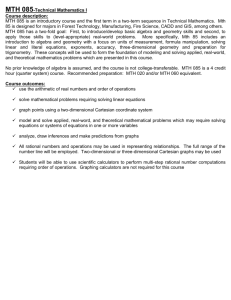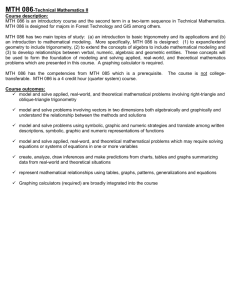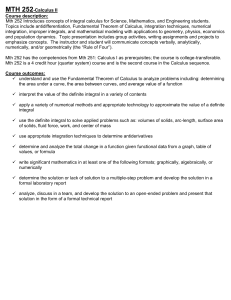MTH 165: Linear Algebra with Differential Equations
advertisement
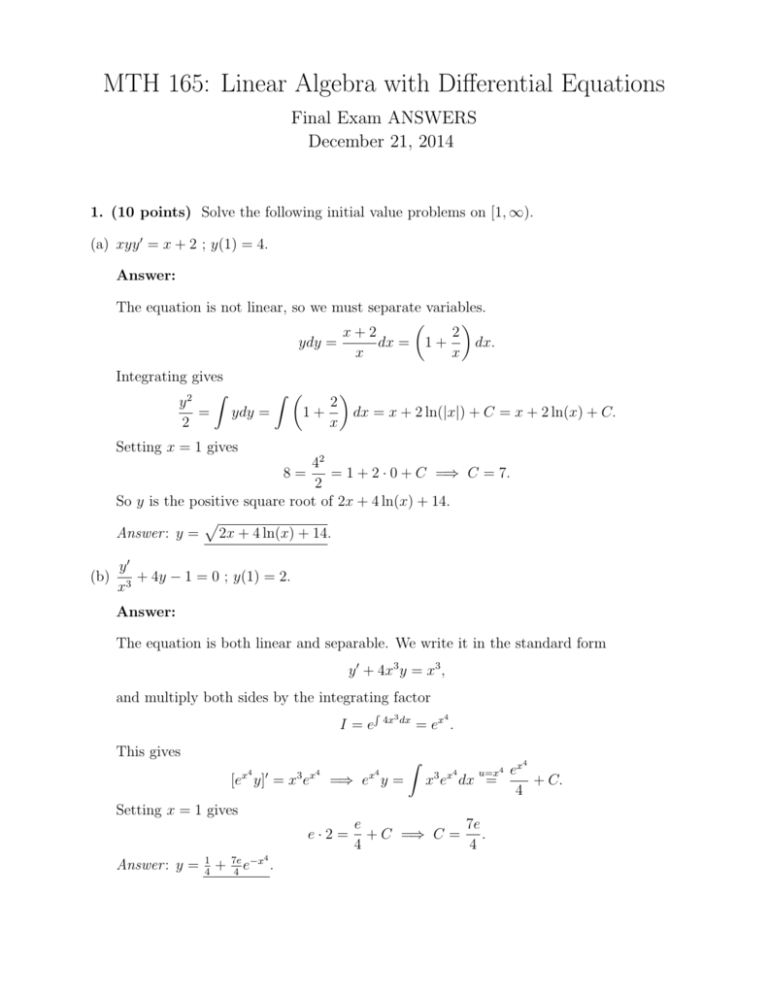
MTH 165: Linear Algebra with Differential Equations
Final Exam ANSWERS
December 21, 2014
1. (10 points) Solve the following initial value problems on [1, ∞).
(a) xyy 0 = x + 2 ; y(1) = 4.
Answer:
The equation is not linear, so we must separate variables.
x+2
2
ydy =
dx = 1 +
dx.
x
x
Integrating gives
Z
Z y2
2
= ydy =
1+
dx = x + 2 ln(|x|) + C = x + 2 ln(x) + C.
2
x
Setting x = 1 gives
42
= 1 + 2 · 0 + C =⇒ C = 7.
2
So y is the positive square root of 2x + 4 ln(x) + 14.
p
Answer : y = 2x + 4 ln(x) + 14.
8=
(b)
y0
+ 4y − 1 = 0 ; y(1) = 2.
x3
Answer:
The equation is both linear and separable. We write it in the standard form
y 0 + 4x3 y = x3 ,
and multiply both sides by the integrating factor
I=e
R
4x3 dx
4
= ex .
This gives
x4
0
3 x4
[e y] = x e
x4
=⇒ e y =
Z
4
ex
+ C.
x e dx =
4
3 x4
u=x4
Setting x = 1 gives
e·2=
Answer : y =
1
4
+
7e −x4
e .
4
e
7e
+ C =⇒ C = .
4
4
December 16, 2014
Final Exam
1 2 0
2. (10 points) Consider the matrix A = 2 4 1.
2 5 0
MTH 165
(a) Compute the determinant of A.
Answer:
Expanding along the third column gives: −1(1 · 5 − 2 · 2) = −1.
Answer : det(A) = −1.
(b) Find A−1 .
Answer:
Following the standard algorithm gives
5 0 −2
Answer : A−1 = −2 0 1 .
−2 1 0
(c) Use your answer to part (b) to solve the following system of equations:
x + 2y = 1
2x + 4y + z = 4
2x + 5y = −3
Answer:
Applying the usual formula Ax = b
5
x = −2
−2
=⇒ x = A−1 b gives
0 −2
1
11
0 1 4 = −5 .
1 0
−3
2
Answer : (x, y, z) = (11, −5, 2).
Page 2 of 11
December 16, 2014
Final Exam
MTH 165
3. (10 points) Let r1 , r2 ∈ R3 be two row vectors, and let k ∈ R be a real number. For
which values of k, if any, is the matrix
r2 + kr1
A = r1 − r2
r1 + r2
invertible? Justify your answer.
Answer:
One of the ways to answer this question is to recall that
A is invertible ⇐⇒ rank(A) = 3 ⇐⇒ rowrank(A) = 3.
The rows of A belong to the span of {r1 , r2 }, which has dimension at most two. Therefore
rowrank(A) ≤ 2 < 3
regardless of what value k assumes.
Answer : No values of k make A invertible.
Page 3 of 11
December 16, 2014
Final Exam
MTH 165
1 2
4. (10 points) Consider the matrix A =
. Let W ⊆ M2×2 (R) be the set of 2 × 2
2 1
real matrices that commute with A:
W = {M ∈ M2×2 (R) : AM = M A}.
(a) Prove that W is a subspace.
Answer:
We verify the three standard properties.
(i) The 2 × 2 zero matrix 02 belongs to W because A02 = 02 = 02 A.
(ii) W is closed under addition: if M, N be two elements of W , then their sum M + N
belongs to W because
A(M + N ) = AM + AN = M A + N A = (M + N )A.
(iii) W is closed under scalar multiplication: if M is an element of W and λ ∈ R, then
the scalar product (λM ) belongs to W because
A(λM ) = λAM = λM A = (λM )A.
(b) Find a basis for W , showing all of your work.
Answer:
a b
Let M =
be an element of W . Then
c d
a + 2c b + 2d
a + 2b b + 2a
a=d
.
= AM = M A =
⇐⇒
c + 2a d + 2b
c + 2d d + 2c
b=c
a b
1 0
0 1
So M =
=a
+b
.
b a
0 1
1 0
1 0
0 1
Therefore M belongs to the span of the set
,
, which is linearly inde0 1
1 0
pendent.
1 0
0 1
Answer : A basis is
,
.
0 1
1 0
Page 4 of 11
December 16, 2014
Final Exam
MTH 165
5. (10 points)
(a) Suppose the linear transformation T : R2 → R2 is given by T (a, b) = (a+b, 0).
(i) Find a matrix A such that T v = Av.
Answer:
1 1
A=
.
0 0
(ii) Find the dimension of the kernel of T .
Answer:
The vector (a, b) belongs to the nullspace of T precisely when
0 0
T (a, b) =
⇐⇒ a + b = 0.
0 0
1
So a basis for the kernel is
. Therefore, its dimension is 1.
−1
Alternatively, the rank of the matrix A in part (a) is 1, and by the rank-nullity
theorem, dim ker (T) = 2 - rank (A) = 1.
Page 5 of 11
December 16, 2014
Final Exam
(b) Suppose the linear transformation T
a
T
c
MTH 165
: M2×2 (R) → M2×2 (R) is given by
b
a
b+c
=
d
b+c
d
(i) Find a basis for the kernel of T .
Answer:
a b
a
b+c
a=d=0
T
=
⇐⇒
.
c d
b+c
d
b+c=0
0 1
So a basis for the kernel is
.
−1 0
(ii) What is the dimension of the range of T ?
Answer:
By the Rank-Nullity Theorem for linear transformations we have
dim(M2×2 (R) = dim(range(T )) + dim(nullity(T )) =⇒ dim(range(T )) = 4 − 1 = 3.
0 −2
(iii) Is
in the range of T ? Briefly justify your answer.
2 0
Answer:
No because if it were b + c would have to simultaneously be 2 and −2.
Page 6 of 11
December 16, 2014
Final Exam
MTH 165
6. (10 points) Let
10 −12 8
1
0 .
A= 0
−8 12 −6
(a) Find the eigenvalues of A.
Answer:
expanding along the middle row gives that the characteristic polynomial is
p(t) = det(A − tI) = (1 − t)[(10 − t)(−6 − t) + 64] = (1 − t)(t2 − 4t + 4) = (1 − t)(2 − t)2 .
The eigenvalues are its roots: λ = 1, 2.
(b) Find a basis for the eigenspace of each eigenvalue found in (a) and state its dimension.
Answer:
12
The standard algorithm gives that a basis for the λ = 1 eigenspace is 1 ; and
−12
1
a basis for the λ = 2 eigenspace is 0 .
−1
(c) Does R3 have a basis consisting of eigenvectors of A? Explain your answer.
Answer:
No because there are only two linearly independent eigenvectors.
Page 7 of 11
December 16, 2014
Final Exam
MTH 165
7. (10 points) Find the general solution of:
y (4) − y (3) − 6y 00 = 0.
Answer:
The auxiliary polynomial is
p(r) = r4 − r3 − 6r2 = r2 (r2 − r − 6) = r2 (r − 3)(r + 2).
Therefore the general solution is
y = c1 e−2x + c2 + c3 x + c4 e3x .
Page 8 of 11
December 16, 2014
Final Exam
MTH 165
8. (10 points) Solve the initial value problem.
y 00 − y = 45 cos(2x),
y(0) = 13, y 0 (0) = 24
Answer:
As always y = yc + yp .
To find yc we look at the auxiliary polynomial p(r) = r2 − 1 = (r + 1)(r − 1). Therefore
yc = c1 e−x + c2 ex .
For yp we guess yp = A cos(2x) + B sin(2x). Substituting in the equation gives
−5A cos(2x) − 5B sin(2x) = 45 cos(2x) =⇒ A = −9, B = 0.
So the general solution is
y = c1 e−x + c2 ex − 9 cos(2x).
The initial conditions give
13 = c1 + c2 − 9
24 = −c1 + c2
=⇒ c1 = −1, c2 = 23.
Putting everything together
y = −e−x + 23ex − 9 cos(2x)
Page 9 of 11
December 16, 2014
Final Exam
MTH 165
9. (10 points) A spring with constant k of 13N/m is loaded with a mass of 9 kg and
brought to equilibrium. At time 0, the mass is still in its equilibrium position but it is given
a velocity of 5m/s. If the mass experiences a resistance (or damping) force in Newtons which
has magnitude 12 times the speed at each point, find the position y(t) of the mass at time t.
Answer:
We chose as positive the direction of the initial velocity. The position y(t) satisfies the
differential equation
my 00 + cy 0 + k = 0 =⇒ 9y 00 + 12y 0 + 13y = 0, y(0) = 0, y 0 (0) = 5.
−2
The auxiliary polynomial is p(r) = 9r2 + 12r + 13. its roots are r =
± i. So the general
3
solution is
y = c1 e−2t/3 cos(t) + c2 e−2t/3 sin(t).
The initial condition y(0) = 0 gives c1 = 0. So
y = c2 e−2t/3 sin(t) =⇒ y 0 = c2 e−2t/3 (cos(t) − 32 sin(t)).
The initial condition y 0 (0) = 5 gives c2 = 5.
y = 5e−2t/3 sin(t)
Page 10 of 11
December 16, 2014
Final Exam
MTH 165
10. (10 points) Find the general solution for the first order linear system:
x01 = 2x1 + x2 − x3
x02 = x1 − x2 − x3
x03 = x2 + x3
Answer:
We must find the eigenvalues and eigenvectors of
2 1
A = 1 −1
0 1
the matrix
−1
−1 .
1
Expanding along the first column gives that the characteristic polynomial is
det(A − tI) = (2 − t)[(t2 − 1) + 1] − [(1 − t) + 1] = (2 − t)(t2 − 1) = (t + 1)(t − 1)(t − 2).
So the eigenvalues are λ = −1, 1, 2.
Corresponding eigenvectors are
1
1
4
−2 , 0 , 1 .
1
1
1
So the general solution is
1
1
4
−t
t
2t
−2 + c2 e 0 + c3 e 1
x(t) = c1 e
1
1
1
Page 11 of 11
